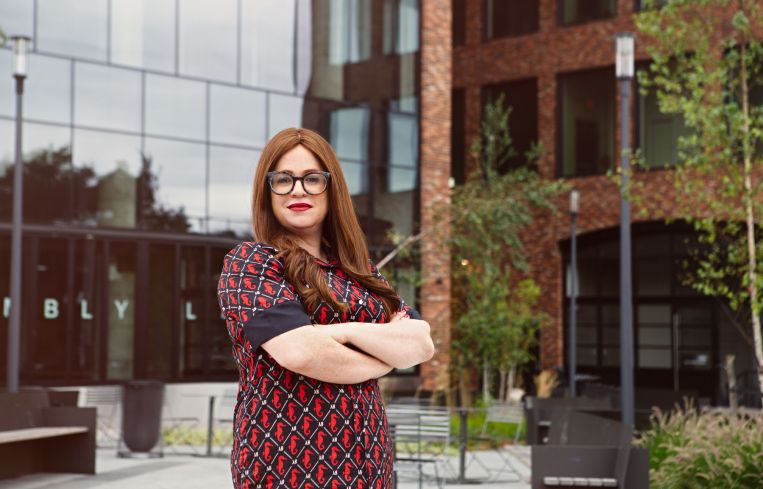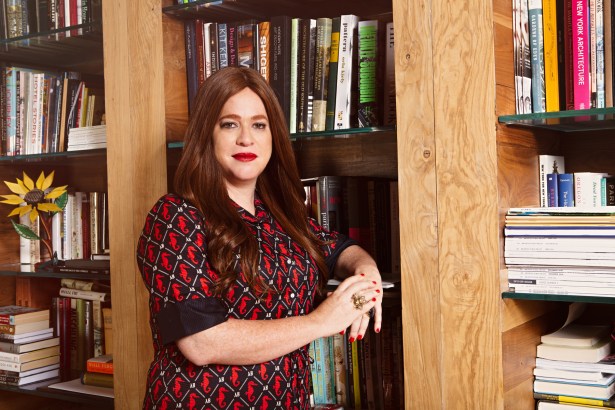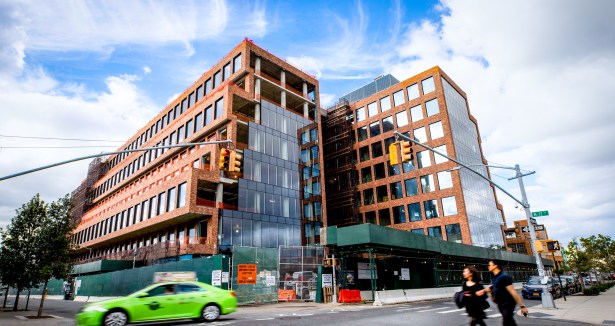The Promised Land: How Toby Moskovits Is Building Her Brooklyn Office Empire
By Rebecca Baird-Remba September 17, 2019 3:23 pm
reprints
Toby Moskovits has always been an unusual force to be reckoned with in the real estate world. The 42-year-old Orthodox Jewish single mother of three started out in the venture capital business in Tel Aviv before moving back to New York City to do tech investing for Cammeby’s Capital Group, the investment arm of Ruby Schron’s real estate company. She started buying properties during the Great Recession in 2008 and didn’t look back. In the 11 years since, she’s helped build the Williamsburg Hotel (which last year was rumored to be on the selling block, although Moskovits claimed it was never officially on the market) and 25 Kent Avenue, two buildings that have helped define the North Williamsburg industrial zone.
Commercial Observer sat down with Moskovits in the Williamsburg office of her firm, Heritage Equity Partners, to talk about her childhood in southern Brooklyn, her planned development projects in Sunset Park and East Williamsburg, and her takes on industrial zoning reform and the impact of the new rent regulations.
Commercial Observer: Tell me about your early life, before real estate.
Toby Moskovits: I was born and bred in Brooklyn. I’m a first generation American but my dad was born in a German displaced persons camp after the war and came here when he was three. My grandfather was a Holocaust survivor. My father settled in Midwood; first they lived in Philadelphia, then the Bronx, and they ended up in Brooklyn. He started a business here in Williamsburg. The company was founded in the late 1950s, buying and selling army surplus. My family never bought real estate, but they leased [it].
My dad actually came to see the [Williamsburg] Hotel site after we started construction. Buildings have changed, and I didn’t have the address of his old shop. And he’s like, “That’s where we used to have our building.” I’m like, “Wow, that’s right across the street.”
Where did you grow up?
I grew up in Flatbush on East Seventh Street and Avenue S. It’s between Midwood and Coney Island; I don’t know what they call it now. They call sections of it Gravesend. The neighborhood names go with [what’s in] vogue, whatever the style is at the time. When I was a kid, you lived in Flatbush.
And where do you live now?
Kew Gardens Hills. It used to be the suburban part of New York, that’s how it evolved. It still feels that way. It’s a little less frenetic than in Brooklyn.
What was it like getting into the real estate industry at the absolute bottom of the market, during the recession?
I found myself in a moment where I was an outsider, but I had some credibility with investors and helped them unwind financial obligations. The last piece of it was real estate. Oftentimes in the City of New York, there’s a lot of noise. And it’s very hard to pull yourself out of, we’ll call it, the consensus view of what’s going on. And in 2008, it was particularly difficult, because there were so many bad economic drivers and so much noise.
So, I didn’t come to the situation saying to myself, “Well, the banks are gone and can’t get 80 percent leverage, and what is land really worth?” I was able to look at the fundamentals. There was a fairly strong economy [and] a lot of tech was really just starting to take root. The only gap was that the banks that had been funding these projects were primarily shut down by the FDIC, for reasons that were related— but also unrelated — to the specifics of the deals. That’s how I got involved in real estate.
The first project, which was this building that you’re sitting in right now, is 227 Grand Street. I looked back at a certain point at my notes and I had spoken to maybe 100 lenders [before] I found someone willing to work with us. We paid out a lender and did a number of deals in the market here where we cleaned up distressed situations.
When the market for [distressed opportunities] was emptied out — and it was a pretty short window of time, less than a year — there still was very limited capital by 2009, 2010 — I started using creative things like seller financing to get deals done.
So, from that time after the residential developments, when the markets became frothy again, and land prices went up, I pivoted, and I started to buy sites in the Wythe Avenue district — Williamsburg Hotel, 25 Kent — and started to help grow a commercial district in this neighborhood, which is, I think, a critical part of the success of Williamsburg and crucial to any successful development anywhere in the outer boroughs.

So, that’s what led to the Williamsburg Hotel and 25 Kent?
What I recognized by the beginning of 2011, was that there’s been a tremendous amount of residential development, right in this area, and very little commercial development.
At one point in 2011 I owned the Urban Outfitters site on North 6th Street. I remember going up to the second floor, and [there was] an advertising agency or some kind of tech company called Full Six on the second floor. I walked in and I could have been in San Francisco — these people lounging around on Adirondack chairs. It was sort of a really cool vibe. And I remember asking them, “Where do you guys come from?” And they’re like, “You know, we live in the neighborhood. And we just took this little space.”
I started to think to myself, wow, there are people that actually want to work in the neighborhood. What if I could buy a site and put up a two-story warehouse building and build open plan space for them?
That was what really got me focused on trying to find a site in the commercial district to really build out space for what I recognized, as a venture capitalist, as an entrepreneur, and as a developer, was the start of a movement of people wanting to work closer to home. That led me to the purchase of the site at 25 Kent.
I’m really interested in talking about 215 Moore Street, because I saw it was entering public review. What are your plans for that project? My understanding of it is that it’s a relatively large office building, plus a hotel, right?
I’m not going to speak on the record about that [building’s plan] overall. But I will tell you some of what’s happening there right now.
My vision for the East Williamsburg Bushwick community is that there’s a tremendous amount of tech moving in. Netflix signed a lease. The blockchain industry has taken hold with Consensus. The future of Brooklyn [is] as a center of employment and good jobs.
A lot of that is going to play out in this neighborhood. Dumbo, as an office market, is at a very high occupancy. There’s not that much product coming online. Williamsburg will have a couple million square feet, but the real place of expansion for the borough is going to be in East Williamsburg and Bushwick. I’m very passionate about making sure that that happens in a way in which everybody in the community participates and everybody in the community benefits.
So about two years ago, I hired an entrepreneur in residence, a gentleman named Emerick Patterson, who’s been running an incubator in the building. We’ve done dozens and dozens of meetups, we’ve done hackathons in collaboration with all the local high schools, and events that have been co-hosted with organizations like Barclays, Microsoft, Google. So, we’re really turning this space and the building into a center of the neighborhood, where we’ve already done dozens of hackathons and all sorts of educational initiatives to connect.
The neighborhood, in terms of use, is evolving. We have, on the one hand, traditional tech companies. On the other hand, there are traditional light manufacturing companies, even though my building is not in the Industrial Business Zone. It’s in what the city is calling the innovation district, much closer to the subway. You have TV and film production, there are advertising agencies; it’s a fairly diverse tenancy. And — similar to 25 Kent — we’ve designed a building that’s very versatile in terms of floor plate and column spacing.
So, it’s a commercial building broadly designed for a range of uses that the market will dictate. We work with the same design firm that designed 25 Kent, HWKN, [and] a brilliant architect named Matthias Hollwich. I brought him in to work with me on what we’re calling The Generator at Bushwick-East Williamsburg.
For the last four years, we’ve been working with the Williamsburg High School for Architecture and Design, which is a local high school in Williamsburg that teaches CAD, computer aided design. Every year we run a program [that brings in] people from the Department of City Planning, from borough presidents’ offices, architects, designers, engineers, to teach them about how their skills could be utilized in real jobs. They’ve designed spaces in the Williamsburg Hotel; they’ve designed spaces in 25 Kent; they’ve designed spaces in other of our projects. We worked on the 215 Moore project with them.
That’s taught me a lot about the importance of community engagement, the importance of giving back and the importance of exposing young people to the joy of productivity.

Since we’re on this topic, what do you think of what happened with North Brooklyn IBZ study? Do you feel like it could be improved or changed?
I won’t comment on that, I’ll just say in the borough of Brooklyn, we’re at a pivotal moment where we could find ourselves in a place where we restrict the zoning so the only thing that’s allowable in certain M3-1 districts is last-mile.
It’s a very low density of space-to-employee [ratio]. So, we could find ourselves in a place where all of Maspeth has a few thousand workers in the entire 20 million square feet, or whatever that number is. Everything is automated, whereas 25 Kent has 2,500 to 3,000 workers in half a million square feet.
How are the zoning rules flexible enough to make direct good investment into high growth jobs? And then, what are we doing as a community to make sure that everyone every New Yorker has access to those jobs?
A perfect example of that is if you look at Cumberland Packing. That was a company that was in subsidized space in the Navy Yard. Certainly, I wasn’t involved in meetings. But I can imagine that the EDC and every city agency made extreme efforts to keep them here. And yet, because of the cost of labor, because of other factors that have nothing to do with real estate, they chose to leave the city. I think that we need to have an honest conversation about economic forces beyond our control, that affect manufacturing, and where high-paying jobs will come from and then we need to make sure that we’re giving our young people coming out of high school — whether they go to college or not — the skills that they need to get those jobs.
What’s going on with your residential project in Sunset Park/Greenwood Heights?
I’m in the process of closing on a construction loan at 875 Fourth Avenue. I’m very focused on Sunset Park. My family had that building in Williamsburg but ultimately moved to Sunset Park, so I spent the latter half of my youth there. Industry City has seen a phenomenal transformation. I’m also closing in the next couple weeks on a site in Mott Haven in the South Bronx, another neighborhood I’m very excited about, where I’m building about 150 units. These are buildings that have a look and feel of what we built at St. Johns Place. We are actively continuing to look for sites in the outer boroughs: Brooklyn, Queens, and what’s new for me is Mott Haven and the Bronx. I’ve been studying that market for a couple of years, and it’s one of the last former industrial neighborhoods within 20 minutes of Manhattan.
What do you think of the investment sales market in Brooklyn right now?
The new rent laws are very challenging for owners, and very challenging for the market. It’s going to incentivize people to do things that aren’t necessarily in the best interest of the broader economic environment. I think that there were bad apples who did things inappropriately vis-a-vis tenants, and acted unethically, but the reaction was an overreach. And as a result, if you add that [to] the Amazon pull-out, [there’s] a general tone that feels, to the market inside real estate, anti-business; I think it’s scaring people off. It’s a mistake, in my opinion. We are undergoing a 100-year economic transformation here in the city of New York, that isn’t just about venture [capital] backed companies, even though I think there’s like $13 billion in venture capital that came into the city last year.
It’s about major employers wanting to be here. It’s about New York becoming the center of the future of all of tech, which is really advertising. That’s how everything is being sold. And every major tech employer opening a massive presence here. So ultimately, everybody needs somewhere to live.
Do you have any specific advice for the real estate industry in the wake of the rent reform?
I will say that the real estate industry needs to get better at learning how to be good citizens and learning how to be good neighborhood players. We put a lot of time and effort in at Heritage to do exactly that with our relationships. We have funded a lot of local organizations. And I think that will go a long way to helping repair a break in communication and a perception that the real estate industry doesn’t care about the communities in which it builds.
Talk a walk down the street from your office and knock on the door of your local high school. If you don’t know how to find it, call me. And I’ll help you figure out who your local principal is. And think about what you can do to help create internship programs, mentorship programs, either in your organization or within the tenants in your buildings. If every real estate owner in the city of New York adopted one public school, we would be impacting hundreds of thousands of kids on an annual basis with mentorship and with internships and really change the face of the city. And we’d continue to bring amazing, high-growth employers here.


